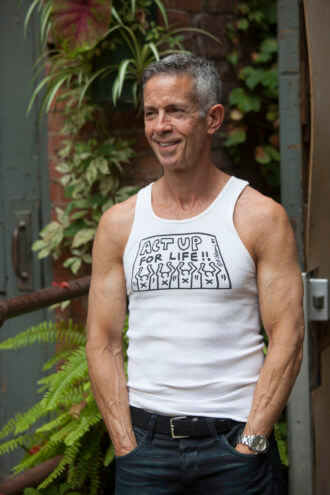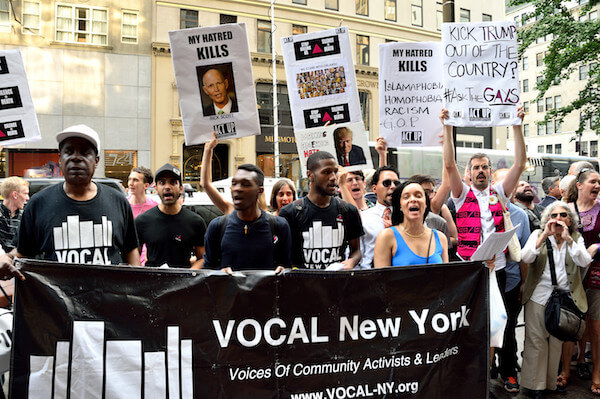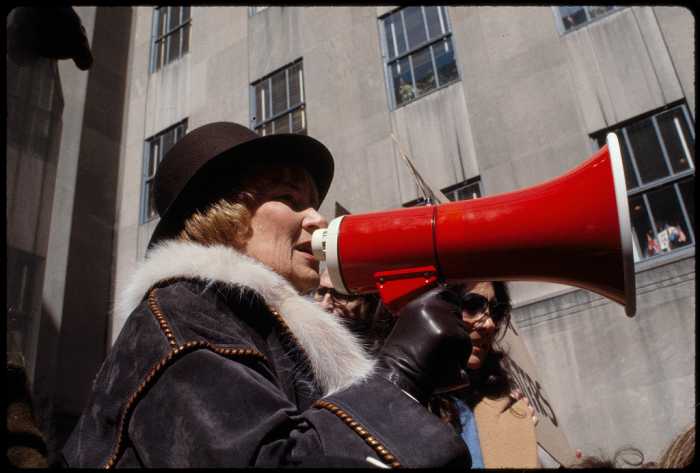Detective Brian Downey, the president of the Gay Officers Action League, at the 2017 World AIDS Day ceremony at the New York City AIDS Memorial in the West Village. | DONNA ACETO
Confronted by a crowd of several thousand who turned out for an October 1998 vigil called to mark the murder of Matthew Shepard who had died in Wyoming just seven days earlier following a brutal anti-gay assault, the NYPD decided that it was not going to allow the vigil to proceed.
Over four hours, the police tried to stall vigil participants on blocks between Fifth and Sixth Avenues as they zigzagged from 59th Street and Fifth Avenue to Madison Square Park. Police arrested 115 people, though roughly 30 of those arrests were later voided but only after those people were held in handcuffs on a city bus for several hours.
The evening’s most dangerous moment came when police trapped several hundred marchers on 43rd Street between Fifth and Sixth Avenues and ordered officers on horses to charge into the crowd. Two marchers suffered broken bones and a third had a concussion.
LGBTQ police group leader says barring uniformed cops in Pride March a non-starter
The police response to the vigil spawned four federal lawsuits, at least 20 complaints to the Civilian Complaint Review Board, New York City’s police monitoring agency, and did immeasurable damage to NYPD-queer community relations.
Fast forward to 2016 when Queer Nation called for a vigil outside the Stonewall Inn less than 48 hours after a gunman killed 49 people in an LGBTQ nightclub in Orlando, Florida.
Like the 1998 vigil, the 2016 vigil had no permit and the organizers (I was among them) had not consulted with police prior to the event. The NYPD reacted very differently. Police closed Christopher Street, the site of the 1969 riots that mark the start of the modern LGBTQ rights movement. The several hundred participants gathered and gave speeches for more than two hours without any objections from police. Toward the end, organizers, who were veterans of ACT UP, Queer Nation, and other activist groups, could be seen thanking police.
“I quarterbacked that,” said Detective Brian Downey, president of the Gay Officers Action League (GOAL), adding that after the Pulse nightclub shooting, “The department leaned on GOAL more than any other time in history.”
The Shepard vigil and the Pulse nightclub vigil could be two events that describe the outer limits of NYPD-queer community relations. Those relations have been good and bad though they have generally gotten better since GOAL was founded in 1982. The fraternal organization has helped LGBTQ members of the NYPD and other law enforcement agencies in its 36 years and has taken steps to improve NYPD-queer community relations.
“We’ve been training recruits for years,” Downey said. “I’ve seen reactions to that training improve.”
GOAL has seen a “dramatic drop off” in calls from members complaining about mistreatment within the NYPD, according to Downey. The group has also trained other law enforcement agencies. It helped create a policy for transgender NYPD members who are transitioning. Later this year, GOAL will present its training to senior commanders in the NYPD.
“This October, GOAL is going to present to everyone ranked captain and above with the police commissioner standing next to us,” Downey said. “It’s his conference.”
GOAL can take some credit for any improved NYPD-queer community relations though views about the extent of that improvement or if it has happened at all probably vary between white and people of color in the city. GOAL’s trajectory within the police department has mirrored the LGBTQ community’s own history.
The founders received death threats in 1982. GOAL was reportedly the subject of an internal police department investigation after it was founded. In 1986, GOAL was protested by mounted NYPD officers who executed an about-face on their horses to turn their backs as GOAL went by during that year’s Pride Parade. One of the officers in that protest was among those who charged the crowd on horseback on West 43rd Street during the 1998 Matthew Shepard vigil. GOAL had to sue the NYPD in 1996 to be allowed to march in uniform in New York City’s Pride Parade and to be treated like every other fraternal organization in the police department.
For Downey, creating change in the NYPD is a long-term project.
“We’ve been running this marathon for 36 years,” the 38-year-old said. “We’re not going to stop.”
In 2018, it is the left that wants GOAL to stop wearing uniforms in New York City’s Pride Parade. The Reclaim Pride Coalition is demanding that Heritage of Pride (HOP), the group that produces New York City’s annual Pride Parade and related events, bar GOAL members from wearing their police uniforms and carrying weapons in the parade. The coalition also wants to limit the policing of the Pride Parade. There has been some ugly rhetoric directed at GOAL during Coalition discussions.
“To me, having the NYPD or [Immigration and Customs Enforcement] in the Pride Parade is like the KKK wanting to be in a Martin Luther King march,” said Travis Morales, a member of the Revolutionary Communist Party, during the Coalition’s May 4 town hall meeting. That remark drew some applause.
Last year, 12 members of Hoods-4Justice were arrested after briefly blockading the Pride Parade just yards from the Stonewall Inn on Christopher Street. Hoods4Justice said it was protesting the NYPD and corporations in the Pride parade though a member at last week’s Coalition town hall said that they were protesting the contingent of Toronto police in New York City’s Pride Parade at the request of Toronto Black Lives Matter.
During a three-hour interview at a Bay Ridge restaurant, Downey declined to comment on the Coalition demands. Last year, he prepared GOAL members for the protest.
“I briefed the membership several times that it was coming,” he said. “I said we are going to hold ourselves to the highest standards.”
What Downey would say is that marching without a uniform would betray what the GOAL founders fought for.
“I will not let their sacrifices and their life’s work be forgotten or dishonored, and taking off those uniforms would be just that,” he said.




































